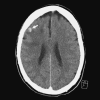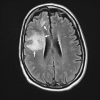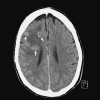Brain abscesses complicating acute pneumococcal meningitis during etanercept therapy
- PMID: 22634540
- PMCID: PMC3494549
- DOI: 10.3121/cmr.2012.1049
Brain abscesses complicating acute pneumococcal meningitis during etanercept therapy
Abstract
Brain abscess formation as a sequelae of community-acquired pneumococcal meningitis is extremely rare, accounting for less than 1% of all meningitis complications. Although metastatic seeding from a distal peripheral septic focus has been observed, this phenomenon most commonly occurs in the context of ear, nose and throat infections, post-cranial neurosurgical procedures, traumatic open cranial injury, or immunosuppression. We present the case of a man, 61 years old, on etanercept therapy for ankylosing spondylitis who developed multiple brain abscesses as a complication of pneumococcal meningitis. We believe that the predisposition to this extremely rare complication of a particularly aggressive pneumococcal meningitis was most likely due to the underlying immunosuppression resulting from etanercept therapy. As far as we know, this case is the first report linking multiple brain abscess formation in a patient with community-acquired pneumococcal meningitis with etanercept therapy.
Figures




Similar articles
-
Anti-TNF-alpha therapy for ankylosing spondylitis.Clin Orthop Surg. 2010 Mar;2(1):28-33. doi: 10.4055/cios.2010.2.1.28. Epub 2010 Feb 4. Clin Orthop Surg. 2010. PMID: 20190998 Free PMC article.
-
Chronic necrotizing pulmonary aspergillosis in a patient treated with a tumor necrosis factor-alpha inhibitor.Int J Rheum Dis. 2010 Aug;13(3):e16-9. doi: 10.1111/j.1756-185X.2010.01528.x. Int J Rheum Dis. 2010. PMID: 20704604
-
Alopecia areata during etanercept therapy.Ocul Immunol Inflamm. 2009 Mar-Apr;17(2):127-9. doi: 10.1080/09273940802596559. Ocul Immunol Inflamm. 2009. PMID: 19412875
-
Etanercept: in ankylosing spondylitis.BioDrugs. 2004;18(3):199-205; discussion 206. doi: 10.2165/00063030-200418030-00006. BioDrugs. 2004. PMID: 15161337 Review.
-
[Anti-TNF alfa therapy in ankylosing spondylitis].Acta Med Port. 2006 Mar-Apr;19(2):141-50. Epub 2006 Aug 18. Acta Med Port. 2006. PMID: 17187716 Review. Portuguese.
Cited by
-
Effects of etanercept, a tumor necrosis factor receptor fusion protein, on primary cell cultures prepared from intact human intervertebral disc tissue.Exp Ther Med. 2019 Jul;18(1):69-76. doi: 10.3892/etm.2019.7559. Epub 2019 May 8. Exp Ther Med. 2019. PMID: 31258639 Free PMC article.
-
Pituitary Abscess: A Rare Clinical Entity in the Presence of Acute Rhinosinusitis: A Case Report.J Neurol Surg Rep. 2018 Apr;79(2):e36-e40. doi: 10.1055/s-0038-1656531. Epub 2018 May 25. J Neurol Surg Rep. 2018. PMID: 29845000 Free PMC article.
References
-
- Bazzoni F, Beutler B. The tumor necrosis factor ligand and receptor families. N Engl J Med 1996;334:1717-1725 - PubMed
-
- Tobinick E. Tumour necrosis factor modulation for treatment of Alzheimer's disease: rationale and current evidence. CNS Drugs 2009;23:713–725 - PubMed
-
- Bresnihan B, Cunnane G. Infection complications associated with the use of biologic agents. Rheum Dis Clin North Am 2003;29:185-202 - PubMed
Publication types
MeSH terms
Substances
LinkOut - more resources
Full Text Sources
Research Materials
